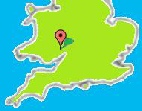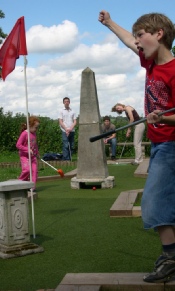









Open from 10:00 daily






Wye Valley MINIATURE GOLF
Now with two great 12-hole courses:
NEW Indoor ADVENTURE GOLF
Play on our unique course inspired by local legends surrounding King Arthur. Our course lies in the very shadow of the hill where Uther Pendragon first met Vortigern’s wizard Merlin.
You’ll be playing indoors from the Sword in the Stone to the Kings Thorne and the Quest for the Grail. Keep your eyes peeled and you might spot the red and the white dragons, the crown of Arthur and Robin Redbreast.
Find out about our local legends
Outdoor MINIATURE GOLF
A roman ruin fantasy set in spectacular scenery in the Wye Valley, inspired by roman remains found further up White Brook and on the other side of the River Wye.
An outstanding outdoor course with all-weather artificial-turf fairways. The design unites a picturesque roman ruin theme, retro minigolf style and adventure golf features for ultimate playability for all ages.
Everyone loves the challenge of minigolf, and this course is a real leveller so you never know who’ll win. Where else can children beat their parents with a club in a fair contest?
Soft or short putters are available, so that even a toddler can play.
Local legends which inspired us
The Sword in the Stone
1,500 years ago on our nearest hill, Ambrosius Aurelianus and Uthr Pendragon defeated Gwrtheyrn (Vortigern the Thin in English) and caught his prophet Myrddin, King Gwrtheyrn’s wizard in the fort which gives the hill its name (The Doward (from Llandougarth, “enclosure of two enclosures”). Vortigern The Thin in English) was buried at Ganarew. Myrddin (Merlin in English) later used magic to disguise Uthr as Gorlois so as to win the love of the duke’s wife. Eigr (Igerna or Igraine) welcomed Uthr very gladly, and so Arthur was born at Tintagel. Merlin arranged fo the boy to be fostered, then twelve years later got him accepted as Uthr’s heir when the Arthur drew a sword from a stone. Merlin arranged a special coronation at Caerleon, and afterward the guests went outside to play a game hitting balls with sticks - golf?
King Arthur’s Hall
On The Doward, King Arthur’s cave looks across a saddle to Gwrtheyrn’s Fort. The tale about the cave is not that Arthur sleeps there as the future king. This cave had a secret passage to Merlin’s Cave at New Weir and Arthur’s treasure was kept in it. We might expect the usual tale about the passage disappearing if anyone touches the treasure, but it is no. The hill somehow needed its own Prince - Bedwini - who was appointed by Arthur to be Bishop to his Court at Gelliwig near Caerwent. So what treasure would merit a prince to guard it?
Maybe iron ore and limestone. The ironworks at New Weir became the biggest in Britain until the Industrial Revolution, supplying forges in Goodrich, Ross-on-Wye, Tintern and beyond through nineteen locks on the River Wye.
The Assembly of Giants
Ambrosius sent Uthr to punish the Irish for invading Britain by plunder. He took their stone circle, called Cor Gaure - “Assembly of Giants” - from Killaraus in Ireland (Stonehenge in English). Merlin moved the circle to Salisbury Plain, and rebuilt it as a monument to the noble Britons who’d been killed by the Saxon Hengist’s treachery on “The Night of the Long Knives”. In time, Ambrosius, Uther and his other brother Constance were buried in the circle with four hundred and sixty victims of the massacre. The tale is a folk-memory: The stones were quarried at Craig Rhos-y-felin and Carn Goedeg in Preseli, west Wales. It’s not in Ireland, but in an area occupied by Irish in the time of Ambrosius. The bulestone circle was actually erected at Waun Mawn in Preseli about 5,000 years ago, then moved by land six hundred years later to Salisbury Plain roughly along the route of the A40.
Merlin’s Cave
A French story told that Merlin fell in lust with the Lady of the Lake, Vivianne. She agreed to go with Merlin - if he taught her all the magic that he had inherited from his father, a demon. She being an elf, they’d live underground, but she put him right off her by magic words tattooed on her [bowdlerism - just say “ring”]. He went mad - so she chained him up but kept nagging him for a spell which would put someone to sleep for ever. Being a prophet, he knew that he’d be the victim, so he taught her other magic (A wizard boring his wife to sleep is very ancient). So… he who helped Uther break his vows - and she who would help Guinevere break hers - were locked in a purgatorial relationship by their own broken tryst. BUT what of that secret passage to King Arthur’s Hall? Merlin escaped, because he’s buried at Mynydd Ferthin near Longtown; Vivianne escaped because she went on to foster Lancelot. She lived at the Siege Dolorous (“Seat of Sadness”), which in the local version was at Ewyas Harold. Both places are close to the Black Mountains.
Harmony of the Britons
Arthur is not a historic person, but if kings were known by titles rather than names in what is now South Wales, the Forest of Dean and Herefordshire, we might know who inspired the folk tales: The historic kingdoms of the Silures tribe were united with the Cornovi tribe through conquest and marriage. Their kings had a tradition of electing an Ameraudur (Commander in Chief). Gwrtheyrn was Cornovian. He usurped power across southern Britain after the Romans left, so he lost the support needed to fight invasions from Irish, Picts, Angles and Saxons. He recruited Jutes as mercenaries in return for the land of Kent. He didn’t pay them, so they brought an invasion force. It all led to civil war. King Tewdrig (Theodoric) of Glwysing and Gwent subjugated the Irish in Dyfed, beat the Saxons back, and won the civil war, then retired to monastic life at Tintern for thirty years. Called again to war, he beat a Saxon army at Pont y Saeson but died during evacuation to Flat Holm. He was buried near Caerwent at Mathern and made a saint. His son Meurig had married Onbrawst, the great granddaughter of king Peibiau of Ergyng, so Meurig ruled a Cornovian kingdom too (now South Herefordshire and the Forest of Dean, with a capital at Ariconium, now Weston-under-Penyard). Tewdrig had appointed Meurig to be king of Dyfed. Meurig was also Stater (aide-de-camp) to his own son Athrwys, who was Ameraudur. Meurig got so sick that he had to be carted into battle and was known as “the half-dead king”. Athrwys inherited more kingdoms from Tewdrig and Meurig, and probably the part of Pengwern ruled from Caer Magnis (Kenchester). His youngest son, “Black” Morgan Mwynfawr (the Benefactor) was educated by Gwalchmai (Gawain) and became his heir. Morgan renamed his kingdom and so his dynasty ruled Morgannwg until the time of King Athelstan II.
The Rant of Gildas the Wise
Gildas was a monk who’d trained under St. Illtyd and lived on Flat Holm. He wrote a famous sermon, ranting about the kings of the Britons, blaming them for the ruin and conquest of Britain. It is the only surviving history from the time - 567 AD. He didn’t name Arthur, but raged about Gwtheyrn (Vortigern) and Constantine, who is is usually identified as Cystennin Gorneu. The meaning of “Gorneu” is unclear: Usually translated as Cornwall, it could have meant Genoreu (modern Ganarew, about a mile from here), or it may have meant Kernyw, the name of the people of the Cornovi tribe. Gildas eventually left for Glastonbury and then Brittany, along with refugees. They took the tales of Arthur with them. Breton stories of Arthur were brought back to Britain by the Normans five hundred years later, adding to Welsh folk-tales.
Constantine the Tyrannical Whelp
King Arthur defeated Medraud (Mordred) at Camlann (in north west Wales). Arthur entrusted his crown to Constantine - but disguising himself as an Abbot, Constantine assassinated one son of Medraud at prayer in a church in London, and the other in a monastery at Winchester. Shamed by Gildas, the disgraced Constantine took Holy Orders. He founded the old church (Hen Llan) at Hentland in Mainaur Garth Benni (Goodrich, two miles away from here) on land given to the church by Peibiau, and built the crossing over the Wye to Walford, called Constantine’s Ford, which was used for 1,300 years. In the local tale, allies of Mordred murdered Constantine after three years. He was buried at Stonehenge and made a saint.
Arthur’s Stone
The young Arthur had fought a giant on Merbach Hill near Dorstone, during which the capstone was cracked. That giant may have been Rein, whose fort - Caer Rein - was on Aconbury Hill overlooking Hereford. Rein (or Retho, maybe Rein Dremrudd of Brycheiniog) had challenged Arthur after the upstart youth had humiliated kings Peibiau of Erging and his brother Nyniaw of Gwent. Arthur yoked them to plough like oxen for going to war over sheep in Ewyas. Arthur took the vanquished Rein’s mantle – made from the beard-pelts of the giant’s defeated enemies - as a trophy to wear at his coronation at Caerleon, where he was crowned by Dyffrig, grandson of Peibiau and now Patron Saint of this parish (St. Dubricius in Latin). Dyffrig abruptly resigned his post and wisely became a hermit on Bardsey.
The Kings Thorne
The royal Stuart dynasty were descended from Arthur. Charles I styled himself “Arthur Redivivat” in support of his claim to rule by divine right, and even used Arthur’s Stone as a dining table in 1645. A sprig of The Holy Thorn was sent to Charles by the monks of Glastonbury every Christmas. One, “the Kings Thorne”, was planted near The Castle Inn at Little Birch on Aconbury Hill where royalists lived. It flowered on Twelfth Night (“Old Christmas”) and around Easter for three and a half centuries after The Regicide of “Charles the Martyr”. The Holy Thorn - from which the King’s Thorne scion had come - had sprung miraculously from the staff of Saint Joseph of Arimathea, a tin trader who’d known Jesus, brought His relics to Britain, built the first church in the world at Glastonbury, and converted the British king Arviragus. Thus British Christianity claimed seniority over Roman Catholicism, which had been legalised by Constantine the Great - a Briton who’d been declared Roman Emperor in York. The legend explains William Blake’s lyrics of the hymn “Jerusalem”. The “Blowing of the King’s Thorne” - its flowering - was celebrated by Royalists in Little Birch when monarchy was restored after The Interregnum.
The Quest for the Holy Grail
West Midlands Constabulary went on a fruitless quest for The Holy Grail in 2014 after it was stolen from Weston-under-Penyard. A resident there was using Cwpan Nanteos for a cure. It was a mazer bowl saved from Strata Florida by its monks when Henry VIII dissolved the abbey, and treasured for 400 years by the Jones and Powell families of Nanteos. Some believed it to be the Holy Grail, the cup used by Jesus at The Last Supper which had been sent to Britain by Joseph of Arimathea after he’d arranged the funeral of Jesus. The Dingestow Brut manuscript tells that Eigr, Arthur’s mother, had been a descendant of Joseph’s sister, and her grandfather had been Custodian of The Grail, which explains King Arthur’s obsession with finding the lost relic. Cwpan Nanteos was handed in anonymously after eleven months and is now curated by the National Library of Wales at Aberystwyth.
“It is all true, or it ought to be; and more and better besides. And wherever men are fighting against barbarism, tyranny, and massacre for freedom, law and honour, let them remember that the fame of their deeds, even though they themselves be exterminated, may perhaps be celebrated as long as the world rolls round. Let us then declare that King Arthur… slaughtered innumerable hosts of foul barbarians and set decent folk an example for all time”. - Winston Churchill
Go to TOP